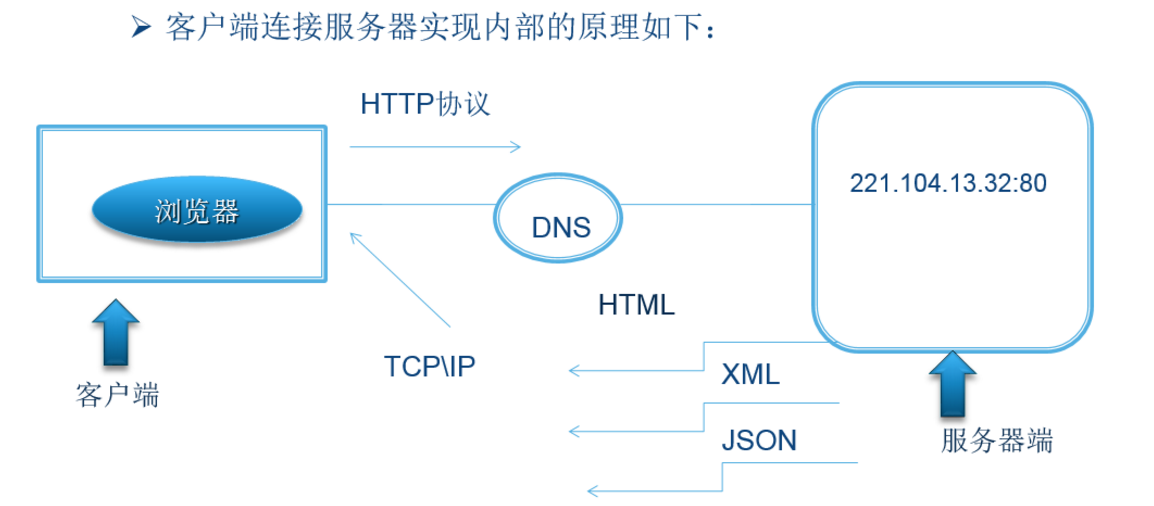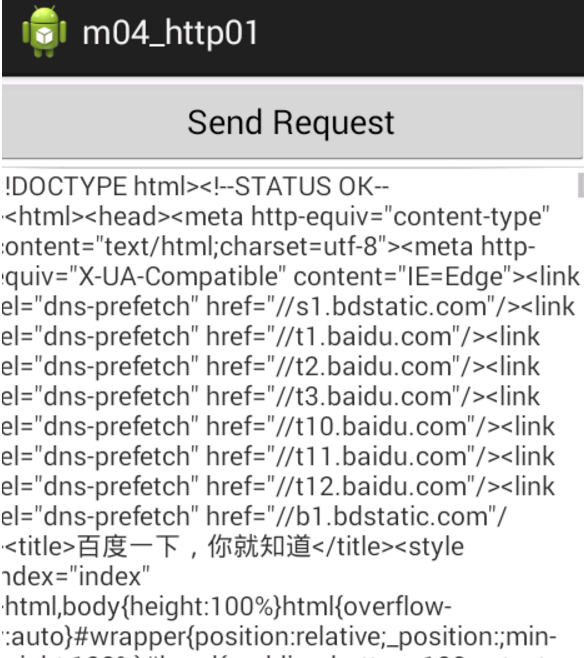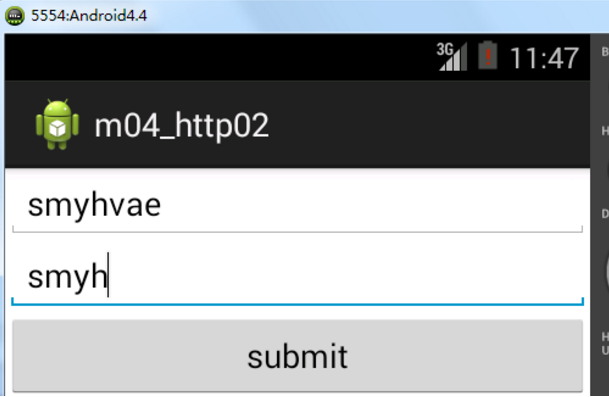Android的HTTP基础与之使用HttpClient和HttpURLConnection
1、客户端连接服务器实现内部的原理:

分析上图,步骤如下:
第一步:在浏览器客户端中得到用户输入的内容。
第二步:浏览器得到这个网址之后,内部会将这个域名发送到DNS上,进行域名解析。得到它的IP之后就会链接到指定的服务器上,假如服务器的地址是:221.104.13.32:80,从浏览器到服务器端口它使用到最底层的TCP/IP协议。
第三步:实现TCP/IP协议用Socket来完成,使用了Socket的套接字。
第四步:服务器端的80端口监听客户端的链接,这样客户端到服务器就链接上了。
服务器接收到这些内容之后,并按照这些请求的路径找到对应的页面,进一步找到对应的网页内容,返回给客户端。
通俗一点讲,用户在浏览器输入网址,通过http协议发出去,网址经过DNS域名解析,解析成指定的ip地址,并在80端口上监听用户的请求。服务器监听到请求之后,会以三种方式返回给客户端:HTML、XML、JASON。
GET方式和POST方式的差别:
GET是从服务器上获取数据,POST是向服务器传送数据。
在客户端,GET方式在通过URL提交数据,数据在URL中可以看到;POST方式,数据放在HTML HEADER内提交。
对于GET方式,服务器端用Request.QueryString获取变量的值,对于POST方式,服务器用Request.Form获取提交的数据。
GET方式提交的数据不能大于2KB(主要是URL长度限制),而POST则没有此限制。
安全性问题。正如2中提到,使用GET的时候,参数会显示在地址栏上,而POST不会。所以,如果这些数据是中文数据而且是非敏感数据,那么使用GET;如果用户输入的数据不是中文字符而且包含敏感数据,那么还是使用POST为好。
HTTP返回请求数据的三种方式:
1、以HTML代码内容返回。
2、以XML字符串的形式返回,在以后的android开发中这种形式返回数据比较多。
3、以JSON对象形式返回,在网络流量上考虑JSON要比XML方式要好一些,便于解析。
在Android当中,一般使用xml和Json数据解析。
2、使用HTTP协议访问网络:
Android中的WebView控件已经在后台帮我们处理好了发送HTTP请求、接收服务响应、解析返回数据,以及最终的页面展示这几步工作,不过由于它封装得太好了,反而不能直观地看出HTTP协议是如何工作的。因此接下来我们通过手动发送HTTP请求的方式,来更加深入的了解这一过程。
在Android上发送HTTP请求的方式一般有两种:HttpURLConnection和HttpCient。我们先来学习HttpCient。
3、HttpCient:
HttpClient是Apache开源组织提供的HTTP网络访问接口(一个开源的项目),从名字上就可以看出,它是一个简单的HTTP客户端(并不是浏览器),可以发送HTTP请求,接受HTTP响应。但是不会缓存服务器的响应,不能执行HTTP页面中签入嵌入的JS代码,自然也不会对页面内容进行任何解析、处理,这些都是需要开发人员来完成的。
现在Android已经成功集成了HttpClient,所以开发人员在Android项目中可以直接使用HttpClient来想Web站点提交请求以及接受响应,如果使用其他的Java项目,需要引入进相应的Jar包。HttpClient可以在官网上下载。官网链接:http://hc.apache.org/downloads.cgi
HttpClient其实是一个interface类型,HttpClient封装了对象需要执行的Http请求、身份验证、连接管理和其它特性。既然HttpClient是一个接口,因此无法创建它的实例。从文档上看,HttpClient有三个已知的实现类分别是:AbstractHttpClient, AndroidHttpClient, DefaultHttpClient,会发现有一个专门为Android应用准备的实现类AndroidHttpClient,当然使用常规的DefaultHttpClient也可以实现功能。
从两个类包所有在位置就可以看出区别,AndroidHttpClient定义在android.net.http.AndroidHttpClient包下,属于Android原生的http访问,而DefaultHttpClient定义在org.apache.http.impl.client.DefaultHttpClient包下,属于对apche项目的支持。而AndroidHttpClient没有公开的构造函数,只能通过静态方法newInstance()方法来获得AndroidHttpClient对象。
简单来说,用HttpClient发送请求、接收响应都很简单,只需要五大步骤即可:(要牢记)
1、创建代表客户端的HttpClient对象。
2、创建代表请求的对象,如果需要发送GET请求,则创建HttpGet对象,如果需要发送POST请求,则创建HttpPost对象。注:对于发送请求的参数,GET和POST使用的方式不同,GET方式可以使用拼接字符串的方式,把参数拼接在URL结尾;POST方式需要使用setEntity(HttpEntity entity)方法来设置请求参数。
3、调用HttpClient对象的execute(HttpUriRequest request)发送请求,执行该方法后,将获得服务器返回的HttpResponse对象。服务器发还给我们的数据就在这个HttpResponse相应当中。调用HttpResponse的对应方法获取服务器的响应头、响应内容等。
4、检查相应状态是否正常。服务器发给客户端的相应,有一个相应码:相应码为200,正常;相应码为404,客户端错误;相应码为505,服务器端错误。
5、获得相应对象当中的数据
4、DefaultHttpClient:
GET方式
布局文件,activity_main.xml
<LinearLayout xmlns:android="http://schemas.android.com/apk/res/android"
xmlns:tools="http://schemas.android.com/tools"
android:layout_width="match_parent"
android:layout_height="match_parent"
android:orientation="vertical"
tools:context=".MainActivity" >
<Button
android:id="@+id/button1"
android:layout_width="match_parent"
android:layout_height="wrap_content"
android:text="Send Request" />
<ScrollView
android:layout_width="match_parent"
android:layout_height="match_parent" >
<TextView
android:id="@+id/TextView1"
android:layout_width="match_parent"
android:layout_height="wrap_content"
android:text="@string/hello_world" />
</ScrollView>
</LinearLayout>
- 1
- 2
- 3
- 4
- 5
- 6
- 7
- 8
- 9
- 10
- 11
- 12
- 13
- 14
- 15
- 16
- 17
- 18
- 19
- 20
- 21
- 22
- 23
- 24
- 25
布局文件中,我们用一个ScrollView来包裹TextView。借助ScrollView控件的话,就可以允许我们一滚动的形式查看屏幕外i的那部分内容。
MainActivity.java的代码如下:
package com.example.m04_http01;
import org.apache.http.HttpEntity;
import org.apache.http.HttpResponse;
import org.apache.http.client.HttpClient;
import org.apache.http.client.methods.HttpGet;
import org.apache.http.impl.client.DefaultHttpClient;
import org.apache.http.util.EntityUtils;
import android.app.Activity;
import android.os.Bundle;
import android.os.Handler;
import android.os.Message;
import android.view.View;
import android.view.View.OnClickListener;
import android.widget.Button;
import android.widget.TextView;
public class MainActivity extends Activity {
public static final int SHOW_RESPONSE = 0;
private Button button_sendRequest;
private TextView textView_response;
private Handler handler = new Handler() {
@Override
public void handleMessage(Message msg) {
super.handleMessage(msg);
switch (msg.what) {
case SHOW_RESPONSE:
String response = (String) msg.obj;
textView_response.setText(response);
break;
default:
break;
}
}
};
@Override
protected void onCreate(Bundle savedInstanceState) {
super.onCreate(savedInstanceState);
setContentView(R.layout.activity_main);
textView_response = (TextView)findViewById(R.id.TextView1);
button_sendRequest = (Button)findViewById(R.id.button1);
button_sendRequest.setOnClickListener(new OnClickListener() {
@Override
public void onClick(View v) {
sendRequestWithHttpClient();
}
});
}
private void sendRequestWithHttpClient() {
new Thread(new Runnable() {
@Override
public void run() {
HttpClient httpCient = new DefaultHttpClient();
HttpGet httpGet = new HttpGet("http://www.baidu.com");
try {
HttpResponse httpResponse = httpCient.execute(httpGet);
if (httpResponse.getStatusLine().getStatusCode() == 200) {
HttpEntity entity = httpResponse.getEntity();
String response = EntityUtils.toString(entity,"utf-8");
Message message = new Message();
message.what = SHOW_RESPONSE;
message.obj = response.toString();
handler.sendMessage(message);
}
} catch (Exception e) {
e.printStackTrace();
}
}
}).start();
}
}
- 1
- 2
- 3
- 4
- 5
- 6
- 7
- 8
- 9
- 10
- 11
- 12
- 13
- 14
- 15
- 16
- 17
- 18
- 19
- 20
- 21
- 22
- 23
- 24
- 25
- 26
- 27
- 28
- 29
- 30
- 31
- 32
- 33
- 34
- 35
- 36
- 37
- 38
- 39
- 40
- 41
- 42
- 43
- 44
- 45
- 46
- 47
- 48
- 49
- 50
- 51
- 52
- 53
- 54
- 55
- 56
- 57
- 58
- 59
- 60
- 61
- 62
- 63
- 64
- 65
- 66
- 67
- 68
- 69
- 70
- 71
- 72
- 73
- 74
- 75
- 76
- 77
- 78
- 79
- 80
- 81
- 82
- 83
- 84
- 85
- 86
- 87
- 88
- 89
- 90
- 91
- 92
- 93
- 94
- 95
- 96
- 97
- 98
- 99
最后要记得在清单文件中声明访问网络的权限:
<uses-sdk
android:minSdkVersion="8"
android:targetSdkVersion="16" />
<uses-permission android:name="android.permission.INTERNET"/>

POST方式
POST提交数据的步骤:
- 构造请求对象;
- 将需要传递给服务器端的数据放置在键值对对象当中;
- 将准备好的键值对放置在List当中;
- 生成代表请求体的对象;
- 将存有请求键值对的List对象放置在请求题对象当中;
- 将请求体对象放置到请求对象当中;
- 发送请求对象
后面的步骤(即处理请求对象)和GET方法是一致的。
package com.example.m04_http02;
import java.io.BufferedReader;
import java.io.InputStreamReader;
import java.util.ArrayList;
import org.apache.http.HttpEntity;
import org.apache.http.HttpResponse;
import org.apache.http.NameValuePair;
import org.apache.http.client.HttpClient;
import org.apache.http.client.entity.UrlEncodedFormEntity;
import org.apache.http.client.methods.HttpGet;
import org.apache.http.client.methods.HttpPost;
import org.apache.http.impl.client.DefaultHttpClient;
import org.apache.http.message.BasicNameValuePair;
import android.app.Activity;
import android.os.Bundle;
import android.util.Log;
import android.view.View;
import android.view.View.OnClickListener;
import android.widget.Button;
import android.widget.EditText;
public class MainActivity extends Activity {
private EditText nameText;
private EditText pwdText;
private Button button;
@Override
protected void onCreate(Bundle savedInstanceState) {
super.onCreate(savedInstanceState);
setContentView(R.layout.activity_main);
nameText = (EditText) findViewById(R.id.nameText);
pwdText = (EditText) findViewById(R.id.pwdText);
button = (Button) findViewById(R.id.button1);
button.setOnClickListener(new OnClickListener() {
@Override
public void onClick(View v) {
String name = nameText.getText().toString();
String pwd = pwdText.getText().toString();
PostThread postThread = new PostThread(name, pwd);
postThread.start();
}
});
}
class GetThread extends Thread {
String name;
String pwd;
public GetThread(String name, String pwd) {
this.name = name;
this.pwd = pwd;
}
@Override
public void run() {
HttpClient httpClient = new DefaultHttpClient();
String url = "http://192.168.1.112:8080/test.jsp?name=" + name+ "&password=" + pwd;
HttpGet httpGet = new HttpGet(url);
try {
HttpResponse response = httpClient.execute(httpGet);
if (response.getStatusLine().getStatusCode() == 200) {
HttpEntity entity = response.getEntity();
BufferedReader reader = new BufferedReader(
new InputStreamReader(entity.getContent()));
String result = reader.readLine();
Log.d("HTTP", "GET:" + result);
}
} catch (Exception e) {
e.printStackTrace();
}
}
}
class PostThread extends Thread {
String name;
String pwd;
public PostThread(String name, String pwd) {
this.name = name;
this.pwd = pwd;
}
@Override
public void run() {
HttpClient httpClient = new DefaultHttpClient();
String url = "http://192.168.1.112:8080/test.jsp";
HttpPost httpPost = new HttpPost(url);
NameValuePair pair1 = new BasicNameValuePair("name", name);
NameValuePair pair2 = new BasicNameValuePair("password", pwd);
ArrayList<NameValuePair> pairs = new ArrayList<NameValuePair>();
pairs.add(pair1);
pairs.add(pair2);
try {
HttpEntity requestEntity = new UrlEncodedFormEntity(pairs);
httpPost.setEntity(requestEntity);
try {
HttpResponse response = httpClient.execute(httpPost);
if (response.getStatusLine().getStatusCode() == 200) {
HttpEntity entity = response.getEntity();
BufferedReader reader = new BufferedReader(
new InputStreamReader(entity.getContent()));
String result = reader.readLine();
Log.d("HTTP", "POST:" + result);
}
} catch (Exception e) {
e.printStackTrace();
}
} catch (Exception e) {
e.printStackTrace();
}
}
}
}
- 1
- 2
- 3
- 4
- 5
- 6
- 7
- 8
- 9
- 10
- 11
- 12
- 13
- 14
- 15
- 16
- 17
- 18
- 19
- 20
- 21
- 22
- 23
- 24
- 25
- 26
- 27
- 28
- 29
- 30
- 31
- 32
- 33
- 34
- 35
- 36
- 37
- 38
- 39
- 40
- 41
- 42
- 43
- 44
- 45
- 46
- 47
- 48
- 49
- 50
- 51
- 52
- 53
- 54
- 55
- 56
- 57
- 58
- 59
- 60
- 61
- 62
- 63
- 64
- 65
- 66
- 67
- 68
- 69
- 70
- 71
- 72
- 73
- 74
- 75
- 76
- 77
- 78
- 79
- 80
- 81
- 82
- 83
- 84
- 85
- 86
- 87
- 88
- 89
- 90
- 91
- 92
- 93
- 94
- 95
- 96
- 97
- 98
- 99
- 100
- 101
- 102
- 103
- 104
- 105
- 106
- 107
- 108
- 109
- 110
- 111
- 112
- 113
- 114
- 115
- 116
- 117
- 118
- 119
- 120
- 121
- 122
- 123
- 124
- 125
- 126
- 127
- 128
- 129
- 130
- 131
- 132
- 133
- 134
- 135
- 136
- 137
- 138
- 139
- 140
- 141
- 142
- 143
- 144
- 145
- 146
- 147
- 148
- 149
- 150
- 151

5、Java中使用HTTP——HttpURLConnection
HttpURLConnection继承了URLConnection,所以在URLConnection的基础上进一步改进,增加了一些用于操作HTTP资源的便捷方法。Java中HttpURLConnection对象通过URL.openConnection()方法来获得,需要进行强制转换。先来介绍几个HttpURLConnection的常用方法:
-
void setConnectTimeout(int timeout):设置连接超时时长,如果超过timeout时长,则放弃连接,单位以毫秒计算。
-
void setDoInput(boolean newValue) :标志是否允许输入。
-
void setDoOutput(boolean newValue):标志是否允许输出。
-
String getRequestMethod():获取发送请求的方法。
-
int getResponseCode():获取服务器的响应码。
-
void setRequestMethod(String method):设置发送请求的方法。
-
void setRequestProperty(String field,String newValue):设置请求报文头,并且只对当前HttpURLConnection有效。
GET方式
这个例子通过GET方式从服务端获取一张图片的信息,并把其保存在本地磁盘中。服务器为本机上的IIS,一张静态图片,直接通过URL访问。
package com.http.get;
import java.io.FileOutputStream;
import java.io.IOException;
import java.io.InputStream;
import java.net.HttpURLConnection;
import java.net.MalformedURLException;
import java.net.URL;
public class HttpUtils {
private static String URL_PATH = "http://192.168.1.106:8080/green.jpg";
/**
* @param args
*/
public static void main(String[] args) {
saveImageToDisk();
}
/**
* 通过URL_PATH的地址访问图片并保存到本地
*/
public static void saveImageToDisk()
{
InputStream inputStream= getInputStream();
byte[] data=new byte[1024];
int len=0;
FileOutputStream fileOutputStream=null;
try {
fileOutputStream=new FileOutputStream("F:\\test.png");
while((len=inputStream.read(data))!=-1)
{
fileOutputStream.write(data,0,len);
}
} catch (IOException e) {
e.printStackTrace();
}
finally
{
if(inputStream!=null)
{
try {
inputStream.close();
} catch (IOException e) {
e.printStackTrace();
}
}
if(fileOutputStream!=null)
{
try {
fileOutputStream.close();
} catch (IOException e) {
e.printStackTrace();
}
}
}
}
/**
* 通过URL获取图片
* @return URL地址图片的输入流。
*/
public static InputStream getInputStream() {
InputStream inputStream = null;
HttpURLConnection httpURLConnection = null;
try {
URL url = new URL(URL_PATH);
if (url != null) {
httpURLConnection = (HttpURLConnection) url.openConnection();
httpURLConnection.setConnectTimeout(3000);
httpURLConnection.setDoInput(true);
httpURLConnection.setRequestMethod("GET");
int responseCode=httpURLConnection.getResponseCode();
if(responseCode==200)
{
inputStream=httpURLConnection.getInputStream();
}
}
} catch (MalformedURLException e) {
e.printStackTrace();
} catch (IOException e) {
e.printStackTrace();
}
return inputStream;
}
}
- 1
- 2
- 3
- 4
- 5
- 6
- 7
- 8
- 9
- 10
- 11
- 12
- 13
- 14
- 15
- 16
- 17
- 18
- 19
- 20
- 21
- 22
- 23
- 24
- 25
- 26
- 27
- 28
- 29
- 30
- 31
- 32
- 33
- 34
- 35
- 36
- 37
- 38
- 39
- 40
- 41
- 42
- 43
- 44
- 45
- 46
- 47
- 48
- 49
- 50
- 51
- 52
- 53
- 54
- 55
- 56
- 57
- 58
- 59
- 60
- 61
- 62
- 63
- 64
- 65
- 66
- 67
- 68
- 69
- 70
- 71
- 72
- 73
- 74
- 75
- 76
- 77
- 78
- 79
- 80
- 81
- 82
- 83
- 84
- 85
- 86
- 87
- 88
- 89
- 90
- 91
- 92
- 93
- 94
- 95
- 96
- 97
- 98
POST方式
这个例子通过POST方式访问一个登陆页面,需要输入用户名(username)和密码(password)。虽然这里使用的Java在讲解问题,但是服务端是使用.Net的框架,一个很简单的HTML页面加一个表单传送的一般处理程序,输入为admin+123为登陆成功,这里不累述了。
package com.http.post;
import java.io.ByteArrayOutputStream;
import java.io.IOException;
import java.io.InputStream;
import java.io.OutputStream;
import java.io.UnsupportedEncodingException;
import java.net.HttpURLConnection;
import java.net.URL;
import java.net.URLEncoder;
import java.util.HashMap;
import java.util.Map;
public class postUtils {
private static String PATH = "http://192.168.222.1:1231/loginas.ashx";
private static URL url;
public postUtils() {
}
static {
try {
url = new URL(PATH);
} catch (Exception e) {
e.printStackTrace();
}
}
/**
* 通过给定的请求参数和编码格式,获取服务器返回的数据
* @param params 请求参数
* @param encode 编码格式
* @return 获得的字符串
*/
public static String sendPostMessage(Map<String, String> params,
String encode) {
StringBuffer buffer = new StringBuffer();
if (params != null && !params.isEmpty()) {
for (Map.Entry<String, String> entry : params.entrySet()) {
try {
buffer.append(entry.getKey())
.append("=")
.append(URLEncoder.encode(entry.getValue(), encode))
.append("&");
} catch (UnsupportedEncodingException e) {
e.printStackTrace();
}
}
buffer.deleteCharAt(buffer.length() - 1);
System.out.println(buffer.toString());
try {
HttpURLConnection urlConnection = (HttpURLConnection) url
.openConnection();
urlConnection.setConnectTimeout(3000);
urlConnection.setDoInput(true);
urlConnection.setDoOutput(true);
byte[] mydata = buffer.toString().getBytes();
urlConnection.setRequestProperty("Content-Type",
"application/x-www-form-urlencoded");
urlConnection.setRequestProperty("Content-Length",
String.valueOf(mydata.length));
urlConnection.setRequestMethod("POST");
OutputStream outputStream = urlConnection.getOutputStream();
outputStream.write(mydata);
int responseCode = urlConnection.getResponseCode();
if (responseCode == 200) {
return changeInputStream(urlConnection.getInputStream(),
encode);
}
} catch (IOException e) {
e.printStackTrace();
}
}
return "";
}
/**
* 把服务端返回的输入流转换成字符串格式
* @param inputStream 服务器返回的输入流
* @param encode 编码格式
* @return 解析后的字符串
*/
private static String changeInputStream(InputStream inputStream,
String encode) {
ByteArrayOutputStream outputStream = new ByteArrayOutputStream();
byte[] data = new byte[1024];
int len = 0;
String result="";
if (inputStream != null) {
try {
while ((len = inputStream.read(data)) != -1) {
outputStream.write(data,0,len);
}
result=new String(outputStream.toByteArray(),encode);
} catch (IOException e) {
e.printStackTrace();
}
}
return result;
}
/**
* @param args
*/
public static void main(String[] args) {
Map<String, String> params = new HashMap<String, String>();
params.put("username", "admin");
params.put("password", "123");
String result=sendPostMessage(params, "utf-8");
System.out.println(result);
}
}

























 1086
1086

 被折叠的 条评论
为什么被折叠?
被折叠的 条评论
为什么被折叠?








